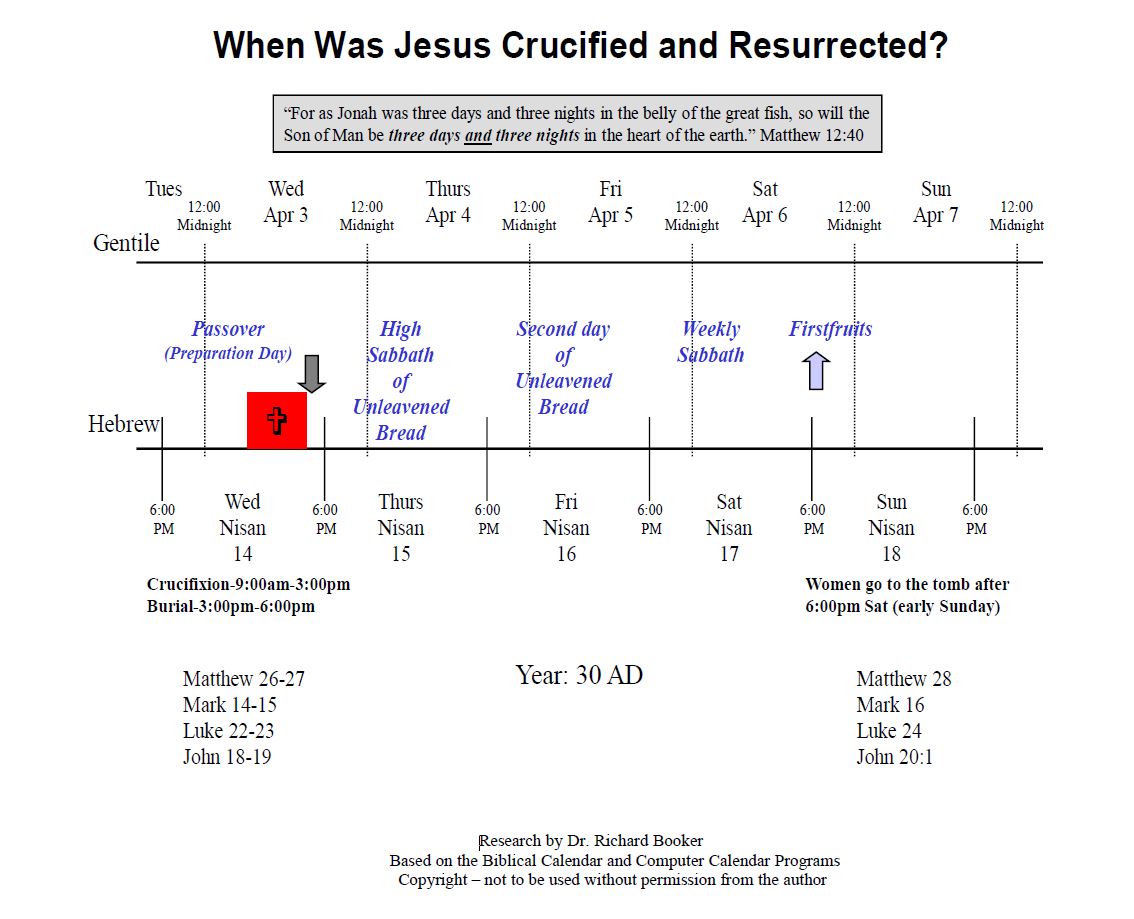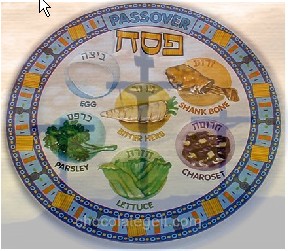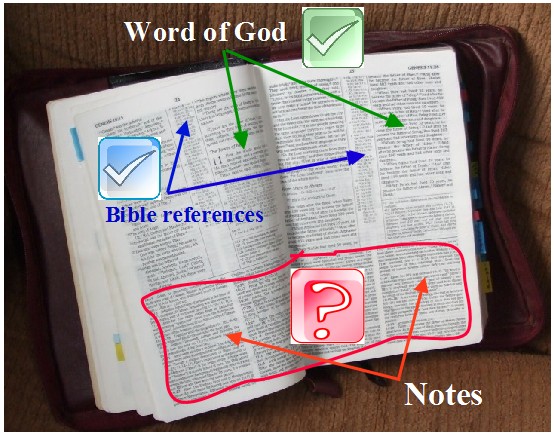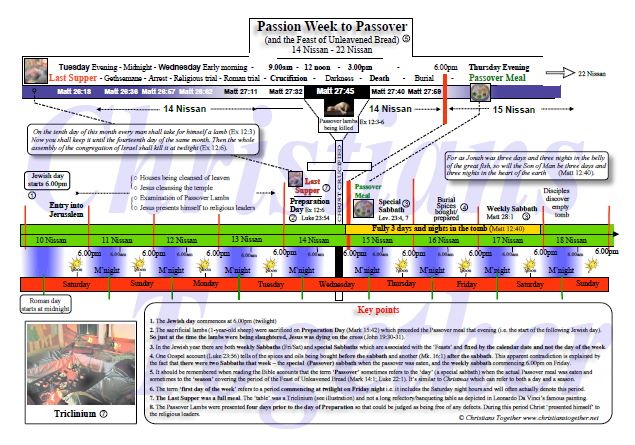 Related Articles
Related Articles
|
|
|
 Websites
Websites
|
|
|
 Files
Files
|
|
|
|
|
Easter; myths and traditions obscure amazing truths
The Passover Meal (Seder) embodies many spiritual truths concerning God's plan of redemption through Jesus Christ. However traditional church teaching (crucified Friday: resurrected Sunday) cannot be supported from a careful study of the Bible; and obscures the immaculate chain of events during the last week of Christ's life.
first published 11/04/2009
UPDATE: 28 March, 2024
The following article has been prefaced by:
 1. A recording of and discussion with Dr. Richard Booker on the subject of Passion Week and the chronology of Christ's crucifixion 1. A recording of and discussion with Dr. Richard Booker on the subject of Passion Week and the chronology of Christ's crucifixion
2. A simplified chart of Richard's detailing his view (and that of the Editor) that Christ was crucified on a Wednesday, just as the sacrificial lambs were being killed for the forthcoming Passover High Holy Day of First Fruits. The article 'When Jesus ate the Passover Meal' explains how Jesus ate the Passover the evening before the Passover lambs were killed.
UPDATE: 16 April, 2025
A presentation entitled Passover and Passion given the week prior to Easter in 2025. Geoff Barnard spoke from his home in Israel to an online audience on the background, nature and timing of Christ’s crucifixion during the Feast of Passover.
Sorry, your browser is unable to play this type of file.
You can still download it
Notes:
1. The above presentation minus the discussion session at the end can be found on YouTube here.
2. Be sure to scroll down to read the whole article (as originally published).
3. There are differing opinions regarding which day of the week Christ was crucified i.e. Wednesday, Thursday or Friday. Please see here for all charts outlining these views.
----------------------------------------
Talk and QnA session with Dr. Richard Booker.
Sorry, your browser is unable to play this type of file.
You can still download it
NOTE: Dr. Booker has written a number of books and it is recommended to visit his website for all information. One of the recommended books is entitled: 'Celebrating Jesus in the Biblical Feasts'.
---------------------------------------------------------
Original Article (04/2009)
 THIS PASSOVER (Pesach) Jewish families will gather around a festive table for the Seder (telling of the story and meal). The story of the Passover will be told from the Haggadah (a Jewish religious text), explaining the story of Moses and the Exodus. And how the Jewish people were in slavery in Egypt. THIS PASSOVER (Pesach) Jewish families will gather around a festive table for the Seder (telling of the story and meal). The story of the Passover will be told from the Haggadah (a Jewish religious text), explaining the story of Moses and the Exodus. And how the Jewish people were in slavery in Egypt.
Accounts are given of Moses confronting Pharaoh and the 10 plagues; how the first-born was spared by the blood of the lamb, and how God parted the Red Sea and delivered the Jewish people from slavery and bondage in Egypt.
A veil over their eyes
However most of the Jewish people living in Israel, the USA and other countries around the world, do not know (or do not understand, or will not accept) that Jesus’ blood was shed on Passover 2000 years ago, delivering them from spiritual bondage and giving them eternal life. And the rabbis forbid the reading of Isaiah Chapter 53 which speaks of Jesus as the suffering servant. (cf John 12:40)
Passover is revealed in many Messianic prophecies, but what is so wonderful is how God's fulfillment of prophecy is so perfect down to the hour! [Interestingly it is said that for religious Jews ‘coincidence’ is not a ‘kosher’ word.]
Easter
And while Gentile Christians rightly focus on the price paid at Calvary and the joy of the subsequent ressurection, there is - in traditional teaching - an anomaly which effectively obscures the full wonder relating to the amazing symmetry of all the events which took place over that momentous Passover season.
A lamb without blemish
Part of the biblical Passover practice was that the lamb, which would be used for the Passover, was to be set aside on the 10th day of the month of Nissan (Ex 12:3). It was then to be tested until the 14th day (Ex 12:6) to be certain it was without spot or blemish before it was killed. [It is interesting to note that part of the ‘testing’ process applied to the sacrificial lambs involved them being whipped lightly on their backs so the white wool became stained with blood - compare this with Jesus’ scourging.]
Jesus as the Passover Lamb was also set aside on the 10th day of Nissan, because it was on this day that He entered Jerusalem, fulfilling the prophecy in Zechariah 9:9. The true significance of His triumphal entry is that this was the occasion Jesus set Himself aside as the Passover Lamb. Jesus was tested from the 10th day until the 14th day of Nissan by the Pharisees, the Sadducees, the Scribes, and the Herodians. By answering all of their objections and questions, Jesus (the Lamb of God) clearly showed that He was without spot and without blemish. (See Footnotes)
Prophecy fulfilled
He was later crucified at nine o'clock in the morning and at the same time as the special Passover animals (lambs or he-goats) were being killed as a sacrifice on the Temple compound.
Just as the Jewish leaders were very careful that not a single bone of the Passover lamb was broken, John 19:36 points out that not a single bone of Jesus was broken either, during His scourging, the crucifixion itself, nor by the Roman soldiers who always broke the victim's legs.
But this year 14 million Jewish people worldwide will celebrate Passover in their homes with family and friends who are gathered around the table for the Seder meal, retelling the story of Passover without the revelation of its ultimate significance. As one Jewish believer (in Yeshua) has written:
‘No one has a clue as they read about God's deliverance in Egypt that the Passover lamb has been fulfilled in Jesus! Even though the Jewish people are known as the "People of the Book," most know little, if anything, about the Messianic prophecies. The rabbis do not investigate or discuss the Messianic prophecies, and they ignore what Moses says: "without the blood atonement, there is no redemption of sin."’ (Lev. 17:11)
What began at the first Passover was later fulfilled by Jesus, once and for all! Moses stood up to Pharoah saying: ‘Let my people go!’ so that the Jewish people would be freed from bondage and they could worship God in freedom.
Today Moses is not here, but the Gentile church is required by God to reach out to the Jewish people so that they can be delivered from eternal death and set free by knowing Jesus the Passover Lamb, who gives freedom and eternal life. And one day the scales will be removed from the Jewish eyes and ‘they will look on Me whom they have pierced; and mourn for Him as an only son’ (Zech 12:10).
Pilgrim Feasts: two fulfilled, one to go
Of all the Jewish feasts detailed in the Bible, Passover was/is the first of the ‘Pilgrim Feasts’ during which the Jews ‘went up’ to Jerusalem to celebrate. (Leviticus 23) Accordingly two of these feasts (Passover and Pentecost) have now found their fullest expression in the outworking of God’s purposes. The Feast of Passover (Ex 12:43; 13:10) was enacted supremely by Jesus’ death on the cross. The Feast of Weeks (50 days after Passover; Deut 16:9-12) saw the Holy Spirit come down at Pentecost.
Tabernacles awaits its greatest hour
But the third of these feasts, The Feast of Tabernacles, yet awaits its greatest expression. Following the opening of the Jewish eyes, the prophet Zechariah goes on to describe momentous events.
‘On that day a fountain will be opened to the house of David and the inhabitants of Jerusalem, to cleanse them from sin and impurity.’ (Zech 13:1) ‘...on that day his feet will stand on the Mount of Olives, east of Jerusalem’. (Zech 14:4)
It will be a time of a great blessing upon the whole world. Paul wrote to the church in Rome: ‘But if their transgression means riches for the world, and their loss means riches for the Gentiles, how much greater riches will their fullness bring!’ (Rom 11:12) and continued by emphasising: ‘For if their rejection is the reconciliation of the world, what will their acceptance be but life from the dead?’ (Rom 11:15). ‘
Glory in the whole earth
The prophet has foretold: ‘The Lord will be king over the whole earth. On that day there will be one Lord, and his name the only name.’ (Zech 14:9)
Though preceded by a time of much tribulation, ‘the survivors from all the nations that have attacked Jerusalem will go up year after year to worship the King, the LORD Almighty, and to celebrate the Feast of Tabernacles.’ (Zech 14:16)
At Passover (the word 'Easter' doesn't appear in the original Bible texts; Note 4.) as we remember the Lord’s death and celebrate his resurrection, we do so ‘until He comes’. (1 Cor. 11:26)
He is Risen. Hallelujah!
Amen. Come Lord Jesus!
----------------------
'Easter' myths obscure the true wonder of it all
For as Jonah was three days and three nights in the belly of a huge fish, so the Son of Man will be three days and three nights in the heart of the earth. Matthew 12:40
Jesus was crucified on Wednesday, not Friday
 Church tradition teaches that Jesus was crucified on Friday and rose again early on Sunday morning. Church tradition teaches that Jesus was crucified on Friday and rose again early on Sunday morning.
This contradicts the passages which tell us that Jesus would be 3 days and 3 nights in the grave (e.g. Matt 12:40; 26:61; 27:63). And suggesting (in this case) that 'a part of day is equal to a whole day' does violence to the word of God.
In fact Jesus was crucified earlier in the week; and he would have been dying on Calvary’s cross on ‘preparation day’ (Luke 23:54) at precisely the same time as the High Priest priests would have been sacrificing the passover lambs for the nation in the temple precincts.
This satisfied the Jewish leaders' desire to avoid having Jesus killed 'during the Feast' (Matt. 26:5).
The High Priest concluded the 2-day slaughter of the sacrifices at 3.00pm on 14 Nisan with the cry: "It is finished" (cf John 19:30). What a wonder of God's precision and of that amazing symmetry.
Jesus was then buried before the annual (Passover) sabbath (John 19:31) – the day of Passover which commenced at 6.00pm on that same day. He then rose three days later, after the weekly sabbath (Mark 16:9), fulfilling the typology of Jonah to which Jesus had referred (see later notes).
Click on image below for chart showing events of Passion Week

The Firstfruit(s) of our Salvation
Since Jesus was crucified on Preparation Day (John 19:31 et al) – on 14 Nisan according to the Essene calender; the day before the main Passover – and was resurrected three days and nights after He was crucified, Jesus arose from the grave on the seventeenth of Nisan, a day of the festival of First Fruits. In fact, Jesus is called the first fruits of those who rise from the dead.
But now is Christ risen from the dead, and become the firstfruits of them that slept. For since by man came death, by man came also the resurrection of the dead. For as in Adam all die, even so in Christ shall all be made alive. But every man in his own order: Christ the firstfruits; afterward they that are Christ's at his coming (1 Corinthians 15:20-23).
The keys to understanding the (Passover) timeline of Jesus' last week lie in the knowledge that –
(a) The Jewish 'day' ran from twilight on one day until twilight the next. For the Jews the evening that Jesus died was actually a new day.
(b) Passover was both a 'day' and a 'week'
The term ‘Passover’ was applied both to a single day and also to a 'period of days'; in much the same way as we talk about Christmas as being a ‘day’ but also a ‘season’. The Passover day (commencing at sunset on 14 Nisan) was at the commencement of the seven-day Festival (Feast) of Unleavened Bread (15 - 21 Nisan: Lev 23:6; Num 28:17) and 'Passover' became the name for the entire festival. (Luke 22:1).
(c) The Passover lambs had to be tethered for five days before they were killed so that they could be carefully examined for any blemishes, and to allow that period of time to elapse so that any hidden defects would become apparent. If indeed Jesus was crucified in the middle of the week, this four-day period, when he was being 'examined' by the religious leaders, would exactly coincide with the time during which the sacrificial lambs were undergoing scrutiny (Exod. 12:3-6).
(d) There are both weekly and annual sabbaths in Old Testament (Jewish) law
In addition to the weekly Sabbaths (which always fell on a Friday/Saturday) there were also yearly Sabbaths (High Holy Days) which fell on a specific date during a specific month e.g. Passover (day) was/is an annual ‘sabbath’ (John 19:31) and always falls on 14 Nisan (Lev. 23:5-7) – irrespective of what day of the week that is in any one year. So (for instance) at one of the Feasts there would regularly have been two sabbaths within a seven-day period.
This reconciles the apparent contradiction in the Gospels whereby Luke’s account describes the two Marys and Salome preparing the burial spices and perfumes before the Sabbath (Luke 23:56), while Mark’s gospel places this activity after the Sabbath(s) (Mark 16:1 and Note 1.) i.e. the ladies did their preparation work after the (annual) Passover Sabbath (14 Nisan) but before the weekly Sabbath (Friday 6.00pm - Saturday 6.00pm) and in advance of them going to the tomb early on Sunday morning only to find that Jesus had already been resurrected.
Note 1.
In Mark 16:1 the Greek word for 'sabbath' can be used in the plural i.e. the text could read: 'When the Sabbaths (plural) were over...'
Note 2.
The Study Bible version of a highly-respected and most popular modern translation comments - with charts and illustrations - on its chronology of Passion Week, and in its attempts to reconcile its interpretation states: "The Scriptures do not mention this (Wednes)day, but the counting of the days seems to indicate that there was another day concerning which the Gospels record nothing." '[Emphasis added]
So if we are to believe that comment and interpretation, during the most astounding seven days of human history and with four apostles recording the events under the inspiration of the Holy Spirit there was/is one 'missing' day during which nothing of any consequence happened!
See Study Bibles: danger, handle with care!
Note 3. Going by the Essene calendar, the Last Supper was eaten on the night before Passover. It was a full meal and Jesus was - figuratively speaking - the sacrificial lamb at the table.
Note 4.
Easter (Nelson's Illustrated Bible Dictionary)
A feast or festival of the Christian church that commemorates the resurrection of Christ. It is observed and celebrated on the first Sunday following the full moon that occurs on or after March 21--or one week later if the full moon falls on Sunday. In other words, Easter falls between March 22 and April 25.
Easter was originally a pagan festival honoring Eostre, a Teutonic (Germanic) goddess of light and spring. At the time of the vernal equinox (the day in the spring when the sun crosses the equator and day and night are of equal length), sacrifices were offered in her honor. As early as the eighth century, the name was used to designate the annual Christian celebration of the resurrection of Christ.
The only appearance of the word Easter (KJV) is a mis-translation of 'pascha', the ordinary Greek word for 'Passover' <Acts 12:4>.
 Note 5. See also related article: 'Passion Week/Last Supper/Traditions' which includes a recorded interview with Chris Hill. Note 5. See also related article: 'Passion Week/Last Supper/Traditions' which includes a recorded interview with Chris Hill.
Additionally 'Remembering His deth; the snack we call Supper'.
|
Christians Together, 27/03/2024
|
(page
1
2)
| |
|
Editor |
11/05/2022 16:54 |
Sorry Jenny. One of the guidelines on exegesis: "When the plain sense makes common sense seek no other sense". I am not persuaded by a series of suppositions to skirt around the plain sense of the text. So we'll just agree to differ. But I will be interested in what others think.
|
| |
|
Editor |
11/05/2022 22:49 |
Regarding the two Sabbaths and the day of crucifixion, I came across this -
https://www.eaec.org/bibleanswers/the_passover_week.htm
And this -
https://www.eaec.org/bibleanswers/passover-week-two-sabbaths.htm
|
| |
|
Editor |
13/05/2022 12:16 |
Roy Thurley of Christian Friends of Israel writes -
>>>
Passover The crucifixion of our Lord took place at the same moment of time as the spotless Passover lamb was being sacrificed, just across town from Gethsemane, at 3pm on Passover eve. He became our sacrifice for all time.
<<<<
https://www.prophecytoday.uk/study/teaching-articles/item/2513-diary-dates.html
|
| |
|
Philip Wren |
13/05/2022 13:45 |
The ADU rule
But because the 15th and 21st days of Nisan and a day or two of Pentecost, and the 10th, 15th, and 22nd of Tisri, were always sabbatical days or days of rest, and it was inconvenient on two Sabbaths together to be prohibited burying their dead and making ready fresh meat, for in that hot region their meat would be apt in two days to corrupt: to avoid these and such like inconveniences, the Jews postponed their months a day, as often as the first day of Tisri, or which is all one, the third of the month of Nisan, was Sunday, Wednesday and Friday: and this rule they called ADU by the letters Aleph, Dalet, Vav, signifying the numbers 1, 4, 6; that is the 1st, 4th and 6th days of the week, which days we call Sunday, Wednesday and Friday.
Page 163 of ‘Observations upon the Prophecies of Daniel and the Apocalypse of John by Sir Isaac Newton
I don't know where Newton got this information I suspect it is buried in some 16th or 17th century volume hidden away in a Cambridge College library. According to Newton there had to be a day separating two Sabbaths. Therefore Matthew 28: 1, having Sabbaths in the plural forces the conclusion that the crucifixion took place on a Wednesday.
|
| |
|
Jenny Yates |
14/05/2022 11:45 |
Colin, I agree with the principle (worded slightly differently) that: 'When a straightforward reading of Scripture makes sense as it stands, then don't look for any other sense', but your response to me (11th May), whilst not a direct accusation, implies that I am violating this principle, and 'skirt(ing) around the plain sense of the text'.
I strenuously deny any such suggestion! I provided a perfectly logical way to explain the difference between Luke 23:56 and Mark 16:1 which does not necessitate inserting an ordinary day between the two sabbaths. Other discrepancies between the gospels are far more difficult to explain, e.g. The day of the anointing at Bethany; the day Jesus cleansed the temple; the day the fig tree withered!
I looked at the links you gave. Both put the triumphal entry on Sunday, but if Sunday was 10th Nisan, Wednesday was 13th. That leaves only three days (including the illegal over-night trials) for the inspection of the sacrificial Lamb, instead of the legally required four days - 10th to 14th Nisan.
It is possible to take the 'plain sense' of Scripture over-literally and conclude that believers should hate their families, and even, in some situations, pluck out their eyes or castrate themselves! (As Origen did!) Clearly, Jesus was using idioms.
Jonathan Sarfati, a Messianic Jew who works with Creation Ministries, says the 'three days and three nights' is simply an idiom, and not to be taken literally. He even opts for the crucifixion being on a Friday. He emphasizes the Jewish way of counting days, where even a small part of a day counts as one day; e.g., if a baby boy is born only a few minutes before sundown, that still counts as the first day, when calculating the day for his circumcision on the 8th day.
https://creation.com/easter-and-good-friday-questions-and-answers
I don't accept Sarfati's conclusion about Friday, because in no way does that allow for three nights, but a Thursday crucifixion does - Thursday and Friday nights, and part/most of Saturday night. Philip Wren's quote from Sir Isaac Newton is interesting, but I can't quite fathom out what he means by 'the Jews postponed their months a day'.
|
| |
|
Editor |
18/06/2024 18:07 |
I have appended a PDF file which gathers together five charts (all from different sources) covering the different (Wed/Thur/Fri) views of when Jesus was crucified.
See - https://christianstogether.net/Publisher/file.aspx?id=355808
|
| |
|
Editor |
20/04/2025 12:29 |
When Jesus Christ rode down the Mount of Olives, entering the city of Jerusalem, everyone looked for Him to turn right, and make His way to the Antonio Fortress, where the Roman occupation authority was garrisoned.
Surely this Leader, this Messiah, this Saviour, this Christ, would rescue Israel from foreign rule – but no.
Jesus turned left, making His royal way to the Temple.
The Temple, the church of the day, was so corrupt, commercial, and prayerless, that Christ took steps to cleanse it from everything that should not have been there.
This was holy love, agape love, in action – nothing soft, flabby, or woolly here!
Those in charge were robbing those who had gathered to worship and pray.
The Temple was intended to be a ‘house of prayer’.
Jesus Christ had come into this world primarily to deal with sin, and with sin He would deal.
Within the week He had given His sacrificial life, and shed His precious blood, to wash people from their sin.
It was Passover, and Jesus Christ is our Passover Lamb.
The donkey on which He rode had never been broken in – His very presence seemed to tame that wild untamed beast – what a lesson.
The wild activities of the Temple demanded something quite different.
The very presence of God can transform all kinds of situations, as can the presence of a servant of God.
Some are pleased and blessed, whilst others rebel and plan to crucify.
When Jesus saw the city of Jerusalem, He wept. His longing and desire was to see people coming to Him, so that He could keep people safe – as a hen gathers her chicks under her wings – “but you were not willing!”
Are you? How willing are you?
Sandy Shaw
("Nairnshire Telegraph" column of 9 years ago)
|
| |
|
Editor |
20/04/2025 13:00 |
>>>>>> quote >>>>>>
only in A.D. 30 did the Essene Passover Eve fall 1 day before the Jewish Passover Eve. In all other years the Essene Passover Eve fell in a different week or fell after (not before) the Jewish Passover.
Consequently, A.D. 30 is the only year in which Jesus and His disciples could observe the Essene Passover exactly one day before the Jews and Pharisees etc. observe the Jewish Passover, and hence A.D. 30 is the only year in which Jesus could both observe Passover in the upper room and then Himself be the sacrificial Passover Lamb of God the following day on Jewish Passover.
No other year satisfies all the criteria to harmonize the gospel Passion Week accounts, and hence A.D. 30 stands alone as the only "fit" for the year of crucifixion.
The differences in which day of the week Passover was observed between the Essenes and the Jews (Pharisees, Sadducees, etc.) is due to their different practices in starting their respective annual calendars. The Fourmilab Calendar Converter determines Hebrew dates according to the Jewish method and Hillel II rules. But that same converter does not compute Essene dates.
It is now generally recognized that prior to the crucifixion of Jesus, there were Essenes in Jerusalem, the "upper room" was likely located in an Essene quarter of Jerusalem, the Essenes were the likely inhabitants of Qumran, and the Essene/Qumran calendar was a 364 day solar calendar at odds with the calendrics of the Sanhedrin..
<<<< end quote <<<<<<
https://theos-sphragis.info/essene_passover_dates.html
|
| |
|
Editor |
20/04/2025 16:56 |
The question has sometimes been asked:
"Why did Jesus seem to tarry in respect of the delay in reaching Lazarus on his death".
An AI response to the question states:
>>>>> Rabbinic literature and later Jewish mystical thought contain the idea that the soul hovers near the body for three days after death, hoping to return, and only departs completely when the body begins to decompose and change color.
This is reflected in midrashic sources such as Genesis Rabbah 100: "For three days the soul returns to the grave, thinking that it will return [to the body]; when, however, it sees that the color of its face has changed, it goes away and leaves it". This notion explains why the story of Lazarus in the New Testament emphasizes he had been dead for four days—signaling he was truly and irreversibly dead according to contemporary Jewish belief.<<<<
This would counter any suggestion from Jesus' Jewish enemies that Lazarus hadn't really died and accordingly there we no miracle in his coming back to life.
If all this is indeed the case then it would add weight to the fact that the sign of Jonah (3 days and 3 nights) would be validating feature of Christ's death and resurrection.
|
| |
|
Boswell |
23/04/2025 16:50 |
I would like to recommend Dr Baruch Korman’s article “The Passover that changed the World” - loveisrael.org/wp-content/uploads/2022/10/Passover_Changed_World.pdf
The article gives explanations of seemingly conflicting statements in the Passover account of the four Gospels. Baruch teaches the Bible verse by verse ‘live’ from the original languages and from a Jewish perspective and context. It anyone notices any error/s he may have made in this writings, or videos, he would be more than happy to hear from them with details of the passages of Scripture which reveal his error/s.
|
(page
1
2)
|
|
|